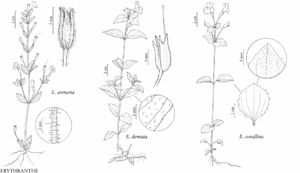Erythranthe arenaria
Phytoneuron 2012-39: 38. 2012.
Annuals, fibrous-rooted or filiform-taprooted. Stems erect to ascending, straight or geniculate at nodes, simple or branched, 5–20 cm, villous-glandular, hairs 0.2–0.8 mm, gland-tipped. Leaves basal and cauline; petiole 0 mm or proximals 1–3 (–5) mm; blade 1-veined or palmately 3-veined, elliptic to narrowly elliptic, ovate-elliptic, or ovatelanceolate, 5–12 (–17) × 3–7 mm, base rounded to cuneate-attenuate, margins entire or sparsely dentate to serrate, apex acuminate to acute or obtuse, surfaces villous-glandular, hairs 0.2–0.8 mm, gland-tipped. Flowers herkogamous, 1–22, from proximal to distal nodes. Fruiting pedicels divergent-arcuate, 10–23 mm, villous-glandular, hairs 0.2–0.8 mm, gland-tipped. Fruiting calyces usually red-dotted, narrowly campanulate, not or weakly inflated, 5–7 (–9) mm, margins distinctly toothed or lobed, villous-glandular, ribs angled, lobes pronounced, erect. Corollas yellow, abaxial limb red-dotted, bilaterally symmetric, weakly bilabiate; tube-throat funnelform, 9–12 (–14) mm, exserted beyond calyx margin; lobes broadly obovate, apex rounded. Styles glabrous. Anthers included, glabrous. Capsules included, 4–7 mm. 2n = 32.
Phenology: Flowering May–Sep.
Habitat: Sandy flats, bars, gullies, washes, trails, roadcuts, seasonal creek beds and drainages, rocky slopes, seepy loam, ditches, lake edges, meadows, openings in pine-fir and pine-oak woodlands.
Elevation: (100–)500–2600(–2800) m.
Discussion
Erythranthe arenaria is known from a cluster of six counties of the central Sierra Nevada: Fresno, Madera, Mariposa, Merced, Tulare, and Tuolumne.
Most plants of Erythranthe arenaria have relatively even-sized cauline leaves, all sessile to proximally subsessile. Plants in the Yosemite area with persistent basal leaves that are short-petiolate, ovate with a cuneate base, and relatively larger than the more distal cauline ones, and possibly related to E. arenaria, have been named M. floribundus var. subulatus. These might be construed as showing the influence of E. geniculata, but that species occurs only at the lower range of elevation of E. arenaria, while plants referable to Mimulus floribundus var. subulatus occur at least to 2300 m and also have the erect habit characteristic of E. arenaria. These variants should be investigated, especially in the Yosemite area where they appear to be relatively common, with the possibility that they indeed represent a distinct entity.
Selected References
None.
